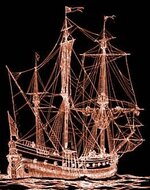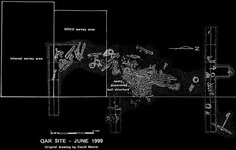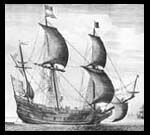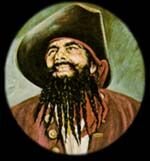imafishingnutt
Bronze Member
- Sep 30, 2007
- 1,675
- 34
- Detector(s) used
- Whites XLT, Tesoro, Whites DFX, Nokta Impact Pro, Ace 400.
- Primary Interest:
- All Treasure Hunting
BLACKBEARD'S FLAGSHIP?
BLACKBEARD'S FLAGSHIP?
I thought this was interesting
Searching a Shipwreck for Clues
by Julie Ann Powers
Reprinted from Coastwatch, a bimonthly magazine of North Carolina Sea Grant. For more information, write Coastwatch, NCSU Box 8605, Raleigh, NC 27695-8605, or check the Sea Grant website: http://www.ncsu.edu/seagrant
Whether a submerged shipwreck near Beaufort Inlet was once a vessel commanded by the infamous pirate Blackbeard is still a secret known only to the sea.
But a convincing picture of an 18th century pirate ship has emerged with the gold dust, broken bottles and cannons brought up from the shell-encrusted mound.
And tantalizing historical parallels prompt officials to stop just short of saying for certain the Queen Anne's Revenge has been found. The flagship of Blackbeard's fearsome fleet was last seen sinking in the inlet after running aground in June 1718.
Jeffrey Crow, N. C. Division of Archives and History director, says divers have yet to find definitive evidence - "a smoking blunderbuss" - to prove the ship's identity.
"But we have found plenty of shot to load that blunderbuss," he says.
Lead shot is among hundreds of artifacts brought up in 500 hours of diving last fall. it was the second major effort to map the site and recover items since the wreck was discovered Nov. 21, 1996, in about 20 feet of water.
A few fold flecks, pewter dishes, a syringe, navigational instruments, onion-shaped wine bottles, a clay pipe and barrel hoops are also products of the latest dive. A bronze bell, a brass blunderbuss barrel, cannons and cannon balls, a sounding weight, broken bottles and ballast stones were brought up in previous dives.
Researchers still hope to find indisputable proof the ship is what they think it is - ideally something engraved Queen Anne's Revenge or Concorde - the ship's name before Blackbeard captured it. Or maybe Edward Teach or Thatch, the bewhiskered pirate's aliases. Lacking that, they are analyzing each artifact for dates or characteristics that might tell about the ship that carried them nearly three centuries ago.
The gold dust - weighing less than two paper clips - is a valuable find, though its unlikely to signal a treasure trove awaits underwater. Blackbeard probably loaded his loot onto his other vessels before Queen Anne's Revenge succumbed to the waves.
If chemical analysis reveals where the gold originated, however, it might also tell where the ship put into port. According to a recently rediscovered description of Concorde's capture its officers were robbed of gold dust when Blackbeard's band seized the Caribbean-bound slave vessel in 1717. Concorde was overtaken off the coast of St. Vincent in the eastern Caribbean, as it traveled between Senegal and Martinique.
"We haven't found Blackbeard's treasure by any means," Crow says of the shiny bits. "But it is an important clue to what may have been on this particular ship."
Blackbeard had been a privateer preying on French ships during Queen Anne's War before going into pirating for himself. He renamed his prize Queen Anne's Revenge.
The flagship was among four ships in Blackbeard's force, which at times included 300 or more men. The ruthless brigands attacked mariners from New England to the Caribbean. Blackbeard was killed in a gory battle at Ocracoke a few months after the grounding.
The ballast stones from the wreck, used to keep the ship upright, are less scintillating than gold dust but could prove as important. The rocks are a volcanic variety found in the Caribbean and in France. A Caribbean identity wouldn't add anything conclusive to the story. But if analysis shows minerals unique to Nantes, France, where the Concorde first floated, the ballast could point to Blackbeard.
"If we do identify them as being French in origin, that would be an important clue as well," says Crow.
While awaiting the results of such studies and combing archives for more overlooked records, experts contend everything they know so far supports the theory the wreck is what's left of Queen Anne's Revenge. And nothing contradicts it. All items identified so far predate the 1718 sinking.
The bronze bell, one of the first items brought to the surface, is inscribed with the date 1709, and the name IHS Maria. Historians theorize the foot-tall bell was taken from a captured vessel or a plundered port town. Pewter dishes made by London pewterer George Hammond date to the early 1700s. Two onion-shaped English wine bottles are circa 1714.
"That puts us precisely in the period we'd expect to find Queen Anne's Revenge," Crow says.
A pewter syringe brought up last fall could be the renowned pirates mark. Blackbeard had blockaded Charleston's port for a week before heading up the coast toward Beaufort.
"One of the things he was trying to secure was medical supplies for his crew," Crow says. Some accounts say syphilis was widespread among the men.
A pair of chart dividers, also brought up in 1998, is identical to the navigational tool in use today. Other instruments recovered are not so recognizable.
"We aren't altogether sure what they are," Crow says. "Some probably have to do with navigation." Many items might have been common aboard any ship of the times, Crow cautions.
"We can't say that these were Blackbeard's," Crow says. "But they give us important evidence we hope to develop further."
Historians also are studying what is left underwater and its positioning. The compact debris field indicates the ship sank steadily, as one aground would do, rather than tearing apart in a storm. The smallest of three anchors, set 400 feet south of the site, suggests the long-ago sailors tried to kedge off the sandbar.
The anchors are large enough to eliminate the possibility that the wreck is Adventure, Blackbeard's smaller sloop that sank at the same time, possibly while assisting Queen Anne's Revenge. Adventure has not been found.
Hurricane Bonnie in August 1998 reburied some of the wreck, but it also exposed a 27-by-8-foot section of hull. The timber is perfectly preserved by decades in the sand.
"You can see the grain work. You can see the little wooden pegs," says Mark Wilde-Ramsey of the N. C. Underwater Archeology Unit, who led the 1998 dive project.
The wood could fill in several blanks in the shipwreck's story. It will be analyzed and carbon-dated, and the hull shape will be studied for signs the holds were designed for human cargo. The 90-foot Concorde was built of white oak in about 1713 as a slave ship, records say. The three-masted ship had a carrying capacity of 200 tons, a 25-foot beam and a draft of 12 1/1 feet. As Queen Anne's Revenge, it accommodated 125 to 150 pirates.
Divers have counted 18 cannons so far in the jumbled mass. Their number and varying size are strong testimony the wreck was Blackbeard's flagship. Queen Anne's Revenge was armed with 40 of the big cast-iron guns. Three have been brought up for conservation.
"It seems like anywhere you go out there and dig, you find cannons," says Richard Lawrence, head of the underwater archeology unit. Merchant whips of the period probably carried fewer, smaller cannons, experts say, and a naval vessel's firepower would have been more uniform in size.
Smaller armament also points to pirates. Lead shot, found in large quantities, ranges in caliber from the size of BB to the diameter of a dime.
"These could be used in pistols, muskets, blunderbusses, or even put into bags and fired out of a cannon," Lawrence says. The latter is described as the 18th century version of the Molatov cocktail.
"Pirates were interested in antipersonnel-type weaponry," he says. " They wanted to cause the crew to surrender with as little damage as possible."
The closely guarded site is about a mile from Fort Macon's shoreline and 1,200 yards from what is now the inlet's main channel. Geologists say strong currents and shifting sand have covered and uncovered the upper portion of the wreck many times over the centuries.
Intersal Inc., a Boca Raton, Fla., treasure-hunting company, found the wreck. The Tar Heel coastline is known to have claimed hundreds of ships, and Intersal initially was hunting a gold-laden Spanish packet that sank in 1750.
The company began looking for Queen Anne's Revenge in 1988, after reportedly uncovering an eyewitness account of the sinking in a London archive.
North Carolina law dictates that they wreck belongs to the state. Intersal has formed a nonprofit arm to work with North Carolina. Mike Daniel, who found the wreck and now heads the nonprofit group, says the partnership is unusual in the treasure-hunting industry, but Intersal wants the artifacts kept together. objects from most famous shipwrecks have been split up and sold, he says.
"This is probably the most important shipwreck in the world, in my opinion, because of the history that surrounds it," he says. Intersal hopes to recoup $300,000 in expenses by selling the story of the find and possibly artifact reproductions.
When the discovery was announced in 1997, coastal communities such as Bath, Hatteras village, Beaufort and Ocracoke began feuding over which should get the shipwreck goods as a tourist draw.
State officials say the N. C. Maritime Museum in Beaufort is the most likely repository, but it will be years before any major display is ready. In the meantime, the bell, the blunderbuss barrel and other cleaned artifacts periodically circulate the state in a traveling exhibit.
The majority of the 350 items brought to the surface are under conservation at the underwater archeology lab in Kure Beach and the new Gallants Channel lab in Beaufort, which was remodeled from an abandoned scallop house on property acquired by the Friends of the N. C. Maritime Museum in 1996.
Bringing up the entire wreck, as researchers dream of doing, will cost millions and take at least five years; conservation even longer. If, that is, facilities and funds materialize.
Museum supports want to build a 16,000-square-foot conservation lab in Beaufort, described by the Friends president as a "top-grade" operation.
"We're talking about a multimillion-dollar facility," say Grayden Paul jr.
The 1997 and 1998 dives were paid for with $450,000 in state money and $50,000 in local funds. Officials say the cost of in-kind contributions - state facilities, expertise, vessels and equipment - is impossible to calculate.
The next dive is tentatively scheduled for fall, when water conditions are optimal. Even if the shipwreck turns out to be a vessel less renowned than Queen Anne's Revenge, historians say the find nevertheless adds new chapters to nautical knowledge.
The worldwide attention to the wreck causes some consternation about the glorification of pirates, who were akin to modern-day hijackers and terrorists.
"They certainly weren't admirable people," says Betty Ray McCain, secretary of the North Carolina Department of Cultural Resources.
But, she says, elementary school teachers assuage her concerns.
"They tell me, 'We've tried everything on the face of the Earth to get kids interested in history,'" she says. '"And you've finally done it."'
BLACKBEARD'S FLAGSHIP?
I thought this was interesting
Searching a Shipwreck for Clues
by Julie Ann Powers
Reprinted from Coastwatch, a bimonthly magazine of North Carolina Sea Grant. For more information, write Coastwatch, NCSU Box 8605, Raleigh, NC 27695-8605, or check the Sea Grant website: http://www.ncsu.edu/seagrant
Whether a submerged shipwreck near Beaufort Inlet was once a vessel commanded by the infamous pirate Blackbeard is still a secret known only to the sea.
But a convincing picture of an 18th century pirate ship has emerged with the gold dust, broken bottles and cannons brought up from the shell-encrusted mound.
And tantalizing historical parallels prompt officials to stop just short of saying for certain the Queen Anne's Revenge has been found. The flagship of Blackbeard's fearsome fleet was last seen sinking in the inlet after running aground in June 1718.
Jeffrey Crow, N. C. Division of Archives and History director, says divers have yet to find definitive evidence - "a smoking blunderbuss" - to prove the ship's identity.
"But we have found plenty of shot to load that blunderbuss," he says.
Lead shot is among hundreds of artifacts brought up in 500 hours of diving last fall. it was the second major effort to map the site and recover items since the wreck was discovered Nov. 21, 1996, in about 20 feet of water.
A few fold flecks, pewter dishes, a syringe, navigational instruments, onion-shaped wine bottles, a clay pipe and barrel hoops are also products of the latest dive. A bronze bell, a brass blunderbuss barrel, cannons and cannon balls, a sounding weight, broken bottles and ballast stones were brought up in previous dives.
Researchers still hope to find indisputable proof the ship is what they think it is - ideally something engraved Queen Anne's Revenge or Concorde - the ship's name before Blackbeard captured it. Or maybe Edward Teach or Thatch, the bewhiskered pirate's aliases. Lacking that, they are analyzing each artifact for dates or characteristics that might tell about the ship that carried them nearly three centuries ago.
The gold dust - weighing less than two paper clips - is a valuable find, though its unlikely to signal a treasure trove awaits underwater. Blackbeard probably loaded his loot onto his other vessels before Queen Anne's Revenge succumbed to the waves.
If chemical analysis reveals where the gold originated, however, it might also tell where the ship put into port. According to a recently rediscovered description of Concorde's capture its officers were robbed of gold dust when Blackbeard's band seized the Caribbean-bound slave vessel in 1717. Concorde was overtaken off the coast of St. Vincent in the eastern Caribbean, as it traveled between Senegal and Martinique.
"We haven't found Blackbeard's treasure by any means," Crow says of the shiny bits. "But it is an important clue to what may have been on this particular ship."
Blackbeard had been a privateer preying on French ships during Queen Anne's War before going into pirating for himself. He renamed his prize Queen Anne's Revenge.
The flagship was among four ships in Blackbeard's force, which at times included 300 or more men. The ruthless brigands attacked mariners from New England to the Caribbean. Blackbeard was killed in a gory battle at Ocracoke a few months after the grounding.
The ballast stones from the wreck, used to keep the ship upright, are less scintillating than gold dust but could prove as important. The rocks are a volcanic variety found in the Caribbean and in France. A Caribbean identity wouldn't add anything conclusive to the story. But if analysis shows minerals unique to Nantes, France, where the Concorde first floated, the ballast could point to Blackbeard.
"If we do identify them as being French in origin, that would be an important clue as well," says Crow.
While awaiting the results of such studies and combing archives for more overlooked records, experts contend everything they know so far supports the theory the wreck is what's left of Queen Anne's Revenge. And nothing contradicts it. All items identified so far predate the 1718 sinking.
The bronze bell, one of the first items brought to the surface, is inscribed with the date 1709, and the name IHS Maria. Historians theorize the foot-tall bell was taken from a captured vessel or a plundered port town. Pewter dishes made by London pewterer George Hammond date to the early 1700s. Two onion-shaped English wine bottles are circa 1714.
"That puts us precisely in the period we'd expect to find Queen Anne's Revenge," Crow says.
A pewter syringe brought up last fall could be the renowned pirates mark. Blackbeard had blockaded Charleston's port for a week before heading up the coast toward Beaufort.
"One of the things he was trying to secure was medical supplies for his crew," Crow says. Some accounts say syphilis was widespread among the men.
A pair of chart dividers, also brought up in 1998, is identical to the navigational tool in use today. Other instruments recovered are not so recognizable.
"We aren't altogether sure what they are," Crow says. "Some probably have to do with navigation." Many items might have been common aboard any ship of the times, Crow cautions.
"We can't say that these were Blackbeard's," Crow says. "But they give us important evidence we hope to develop further."
Historians also are studying what is left underwater and its positioning. The compact debris field indicates the ship sank steadily, as one aground would do, rather than tearing apart in a storm. The smallest of three anchors, set 400 feet south of the site, suggests the long-ago sailors tried to kedge off the sandbar.
The anchors are large enough to eliminate the possibility that the wreck is Adventure, Blackbeard's smaller sloop that sank at the same time, possibly while assisting Queen Anne's Revenge. Adventure has not been found.
Hurricane Bonnie in August 1998 reburied some of the wreck, but it also exposed a 27-by-8-foot section of hull. The timber is perfectly preserved by decades in the sand.
"You can see the grain work. You can see the little wooden pegs," says Mark Wilde-Ramsey of the N. C. Underwater Archeology Unit, who led the 1998 dive project.
The wood could fill in several blanks in the shipwreck's story. It will be analyzed and carbon-dated, and the hull shape will be studied for signs the holds were designed for human cargo. The 90-foot Concorde was built of white oak in about 1713 as a slave ship, records say. The three-masted ship had a carrying capacity of 200 tons, a 25-foot beam and a draft of 12 1/1 feet. As Queen Anne's Revenge, it accommodated 125 to 150 pirates.
Divers have counted 18 cannons so far in the jumbled mass. Their number and varying size are strong testimony the wreck was Blackbeard's flagship. Queen Anne's Revenge was armed with 40 of the big cast-iron guns. Three have been brought up for conservation.
"It seems like anywhere you go out there and dig, you find cannons," says Richard Lawrence, head of the underwater archeology unit. Merchant whips of the period probably carried fewer, smaller cannons, experts say, and a naval vessel's firepower would have been more uniform in size.
Smaller armament also points to pirates. Lead shot, found in large quantities, ranges in caliber from the size of BB to the diameter of a dime.
"These could be used in pistols, muskets, blunderbusses, or even put into bags and fired out of a cannon," Lawrence says. The latter is described as the 18th century version of the Molatov cocktail.
"Pirates were interested in antipersonnel-type weaponry," he says. " They wanted to cause the crew to surrender with as little damage as possible."
The closely guarded site is about a mile from Fort Macon's shoreline and 1,200 yards from what is now the inlet's main channel. Geologists say strong currents and shifting sand have covered and uncovered the upper portion of the wreck many times over the centuries.
Intersal Inc., a Boca Raton, Fla., treasure-hunting company, found the wreck. The Tar Heel coastline is known to have claimed hundreds of ships, and Intersal initially was hunting a gold-laden Spanish packet that sank in 1750.
The company began looking for Queen Anne's Revenge in 1988, after reportedly uncovering an eyewitness account of the sinking in a London archive.
North Carolina law dictates that they wreck belongs to the state. Intersal has formed a nonprofit arm to work with North Carolina. Mike Daniel, who found the wreck and now heads the nonprofit group, says the partnership is unusual in the treasure-hunting industry, but Intersal wants the artifacts kept together. objects from most famous shipwrecks have been split up and sold, he says.
"This is probably the most important shipwreck in the world, in my opinion, because of the history that surrounds it," he says. Intersal hopes to recoup $300,000 in expenses by selling the story of the find and possibly artifact reproductions.
When the discovery was announced in 1997, coastal communities such as Bath, Hatteras village, Beaufort and Ocracoke began feuding over which should get the shipwreck goods as a tourist draw.
State officials say the N. C. Maritime Museum in Beaufort is the most likely repository, but it will be years before any major display is ready. In the meantime, the bell, the blunderbuss barrel and other cleaned artifacts periodically circulate the state in a traveling exhibit.
The majority of the 350 items brought to the surface are under conservation at the underwater archeology lab in Kure Beach and the new Gallants Channel lab in Beaufort, which was remodeled from an abandoned scallop house on property acquired by the Friends of the N. C. Maritime Museum in 1996.
Bringing up the entire wreck, as researchers dream of doing, will cost millions and take at least five years; conservation even longer. If, that is, facilities and funds materialize.
Museum supports want to build a 16,000-square-foot conservation lab in Beaufort, described by the Friends president as a "top-grade" operation.
"We're talking about a multimillion-dollar facility," say Grayden Paul jr.
The 1997 and 1998 dives were paid for with $450,000 in state money and $50,000 in local funds. Officials say the cost of in-kind contributions - state facilities, expertise, vessels and equipment - is impossible to calculate.
The next dive is tentatively scheduled for fall, when water conditions are optimal. Even if the shipwreck turns out to be a vessel less renowned than Queen Anne's Revenge, historians say the find nevertheless adds new chapters to nautical knowledge.
The worldwide attention to the wreck causes some consternation about the glorification of pirates, who were akin to modern-day hijackers and terrorists.
"They certainly weren't admirable people," says Betty Ray McCain, secretary of the North Carolina Department of Cultural Resources.
But, she says, elementary school teachers assuage her concerns.
"They tell me, 'We've tried everything on the face of the Earth to get kids interested in history,'" she says. '"And you've finally done it."'







 In the middle Keys!!! Art supposedly has all the documents to back this up, infact the pages were stolen from the archives back in the 60's before they had the security measures in place they do now. I have seen some but not all of these documents. Anyway, makes for an interesting story if nothing else.
In the middle Keys!!! Art supposedly has all the documents to back this up, infact the pages were stolen from the archives back in the 60's before they had the security measures in place they do now. I have seen some but not all of these documents. Anyway, makes for an interesting story if nothing else.